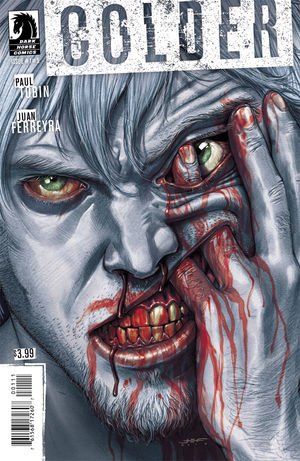art by Juan Ferreyra
 I may have no idea where Tobin is taking this mini-series, but I think I like it that way. During a mysterious fire at an insane asylum in Massachusetts in 1941, in which maniacal doctors are apparently testing a new drug, one of the more menacing villains in recent memory steps naked through a glowing portal and familiarly greets one of its inmates. He whispers intimately and threateningly into Declan's ear—"You will grow...colder" (Colder #1, p. 6)—and, as we soon discover, against all reasonable physical possibility or medical explanation, Declan complies, his body temperature slowly dropping, now at forty-seven degrees, preserving his state for more than seventy years.
I may have no idea where Tobin is taking this mini-series, but I think I like it that way. During a mysterious fire at an insane asylum in Massachusetts in 1941, in which maniacal doctors are apparently testing a new drug, one of the more menacing villains in recent memory steps naked through a glowing portal and familiarly greets one of its inmates. He whispers intimately and threateningly into Declan's ear—"You will grow...colder" (Colder #1, p. 6)—and, as we soon discover, against all reasonable physical possibility or medical explanation, Declan complies, his body temperature slowly dropping, now at forty-seven degrees, preserving his state for more than seventy years.Declan may be positioned to be the series' hero, or at least its protagonist, but Colder #1 belongs entirely to Nimble Jack, the Joker/Punch/circus-contortionist hybrid who climbed through during the fire. He's always hungry, and he eats people. Not their flesh, their spirits, which he draws out of them in swirls of color. And he disguises their deaths as suicides, as with Declan's falling temperature, by simply suggesting it to them. Colder picks back up when Jack smells Declan on his caretaker, the psychiatric nurse Reece, who assumed custody of him after their clinic folded five years earlier. Following her home after a mugging, Jack confronts the comatose Declan once again, and in the issue's closing moments wakes him.
Ferreyra's artwork is exceptional and perfectly suited to Tobin's story. There's a surprising degree of polish in both the lines and the colors, more pastel, pencil and charcoal than computer finish. But it's Ferreyra's characterizations that are truly impressive. His decisions for Nimble Jack, in particular, provide him with a extremely wide expressive range. In addition to Jack's physical...well... nimbleness, his facial features—all eyebrows and wide grin—are equally so.
Note: I have no idea why Tobin chose ergotamine as his evil drug of choice or, indeed, why psychiatric doctors or neuro-physicians in the 1940s might be using it on mental patients. It is an actual drug, a vasoconstrictor most commonly prescribed to treat migraines. To my knowledge, it has no effect on existing chemical imbalance or mental instability, nor can it trigger them, making its selection for Tobin's story seem arbitrary.
No comments:
Post a Comment